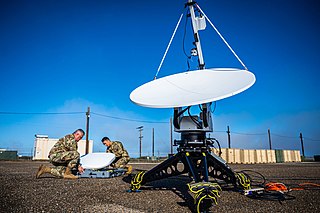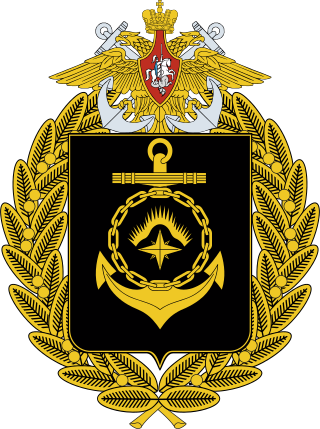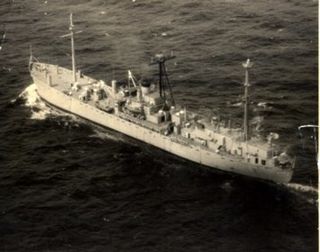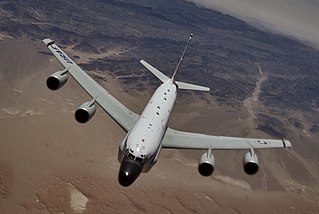
The German Navy is part of the unified Bundeswehr, the German Armed Forces. The German Navy was originally known as the Bundesmarine from 1956 to 1995, when Deutsche Marine became the official name with respect to the 1990 incorporation of the East German Volksmarine. It is deeply integrated into the NATO alliance. Its primary mission is protection of Germany's territorial waters and maritime infrastructure as well as sea lines of communication. Apart from this, the German Navy participates in peacekeeping operations, and renders humanitarian assistance and disaster relief. It also participates in anti-piracy operations.

Signals intelligence (SIGINT) is the act and field of intelligence-gathering by interception of signals, whether communications between people or from electronic signals not directly used in communication. As classified and sensitive information is usually encrypted, signals intelligence may necessarily involve cryptanalysis. Traffic analysis—the study of who is signaling to whom and in what quantity—is also used to integrate information, and it may complement cryptanalysis.

Electromagnetic warfare or electronic warfare (EW) is warfare involving the use of the electromagnetic spectrum or directed energy to control the spectrum, attack an enemy, or impede enemy operations. The purpose of electromagnetic warfare is to deny the opponent the advantage of—and ensure friendly unimpeded access to—the EM spectrum. Electromagnetic warfare can be applied from air, sea, land, or space by crewed and uncrewed systems, and can target communication, radar, or other military and civilian assets.

The Russian Navy is the naval arm of the Russian Armed Forces. It has existed in various forms since 1696. Its present iteration was formed in January 1992 when it succeeded the Navy of the Commonwealth of Independent States.

USS Mount Whitney is one of two Blue Ridge-class amphibious command ships of the United States Navy and is the flagship and command ship of the United States Sixth Fleet. USS Mount Whitney also serves as the Afloat Command Platform (ACP) of Naval Striking and Support Forces NATO (STRIKFORNATO). The ship had previously served for years as the COMSTRIKFLTLANT(NATO Designation) / US Second Fleet's command ship. She is one of only a few commissioned ships to be assigned to Military Sealift Command.

The Northern Fleet is the fleet of the Russian Navy in the Arctic.

The Baltic Fleet is the fleet of the Russian Navy in the Baltic Sea.

A spy ship or reconnaissance vessel is a dedicated ship intended to gather intelligence, usually by means of sophisticated electronic eavesdropping. In a wider sense, any ship intended to gather information could be considered a spy ship.

The Bulgarian Navy is the navy of the Republic of Bulgaria and forms part of the Bulgarian Armed Forces.

The Ropucha class, Soviet designation Project 775, is a class of landing ship built in Poland for the Soviet Navy. The ships were built in the Stocznia Północna shipyards in Gdańsk, Poland. They were designed for beach landings, and can carry 450 tons of cargo. The ships have both bow and stern doors for loading and unloading vehicles, and the 630 square metres (6,800 sq ft) of vehicle deck stretch the length of the hull. Up to 25 armored personnel carriers can be embarked.

USS Jamestown (AGTR-3/AG-166) was an Oxford-class technical research ship acquired by the U.S. Navy for the task of "conducting research in the reception of electromagnetic propagations" (SIGINT).
Signals intelligence by alliances, nations and industries comprises signals intelligence (SIGINT) gathering activities by national and non-national entities; these entities are commonly responsible for communications security (COMSEC) as well.

Signals intelligence operational platforms are employed by nations to collect signals intelligence, which is intelligence-gathering by interception of signals, whether between people or between machines, or mixtures of the two. As sensitive information is often encrypted, signals intelligence often involves the use of cryptanalysis. However, traffic analysis—the study of who is signalling whom and in what quantity—can often produce valuable information, even when the messages themselves cannot be decrypted.
Before the development of radar and other electronics techniques, signals intelligence (SIGINT) and communications intelligence (COMINT) were essentially synonymous. Sir Francis Walsingham ran a postal interception bureau with some cryptanalytic capability during the reign of Elizabeth I, but the technology was only slightly less advanced than men with shotguns, during World War I, who jammed pigeon post communications and intercepted the messages carried.

Russian cruiser Varyag, formerly Chervona Ukraina, is the third ship of the Slava-class of guided missile cruisers built for the Soviet Navy now serving the Russian Navy.

BALTOPS is an annual military exercise, held and sponsored by the Commander, United States Naval Forces Europe, since 1971, in the Baltic Sea and the regions surrounding it.

The Balzam class, Soviet designation Project 1826 is a class of intelligence collection ships built in the Soviet Union for the Soviet Navy during the 1980s. They are also known as Lira class, after the first vessel of the class.

The Vishnya class, Soviet designation Project 864, are a group of intelligence collection ships built for the Soviet Navy in the 1980s. The ships continue in service with the Russian Navy. The Russian Navy operates seven of these ships.

Admiral Tributs is a Project 1155 Large Anti-Submarine Ship of the Russian Navy. Known in the west as an Udaloy-class destroyer, the ship is named after admiral Vladimir Filippovich Tributs. Launched in 1983, Admiral Tributs serves in the Russian Pacific Fleet, and has taken part in operations alongside the naval forces of other nations like China, India and Japan, and as part of a peacekeeping force in the Middle East between 1992 and 1993.

Liman was a Russian naval intelligence vessel that sunk after a collision in 2017 which resulted in no casualties.


















